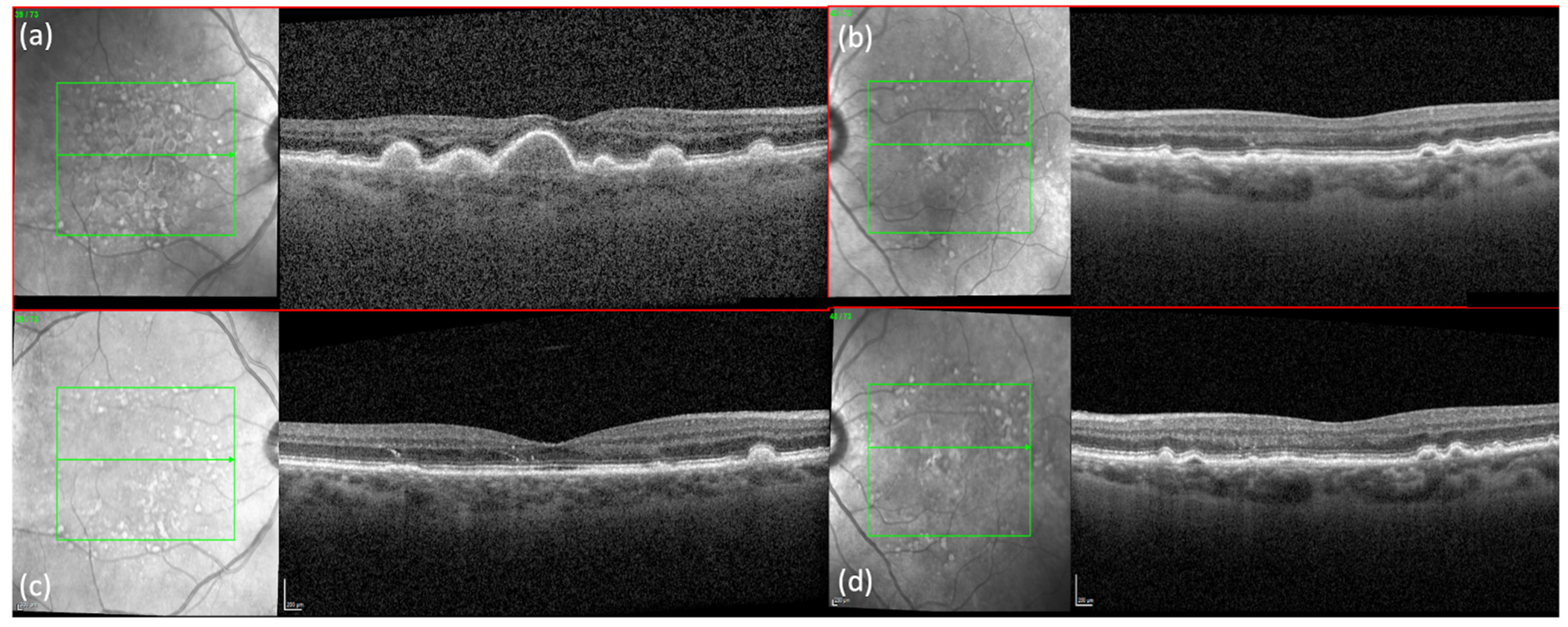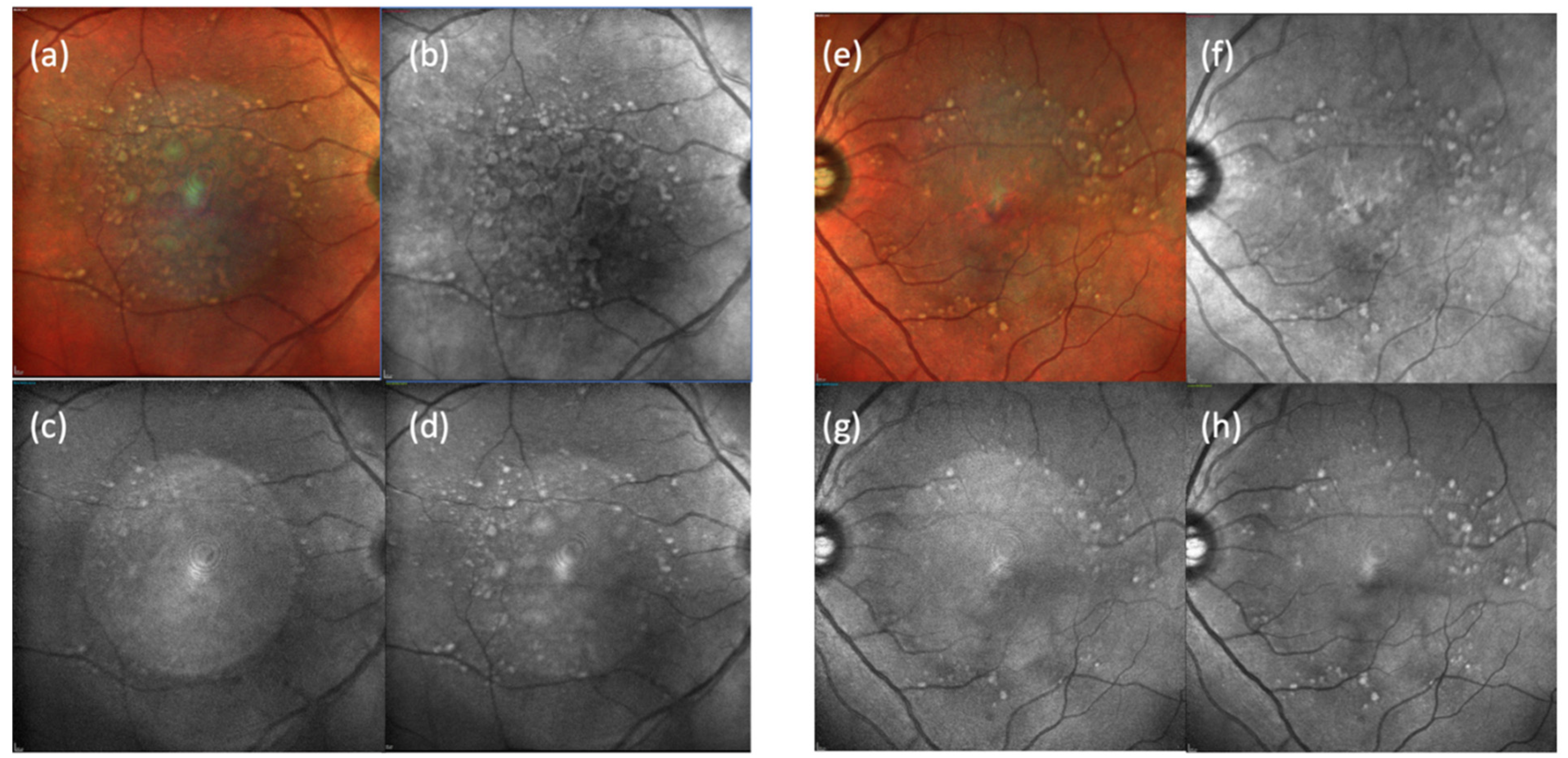Complete Resolution of Central Soft Drusen without Geographic Atrophy or Choroidal Neovascularization
Abstract
:1. Introduction
2. Case Presentation
3. Discussion
4. Conclusions
Author Contributions
Funding
Institutional Review Board Statement
Informed Consent Statement
Conflicts of Interest
References
- Jager, R.D.; Mieler, W.F.; Miller, J. Age-Related macular degeneration. N. Engl. J. Med. 2008, 358, 2606–2617. [Google Scholar] [CrossRef] [PubMed] [Green Version]
- Yehoshua, Z.; Wang, F.; Rosenfeld, P.J.; Penha, F.; Feuer, W.J.; Gregori, G. Natural history of drusen morphology in age-related macular degeneration using spectral domain optical coherence tomography. Ophthalmology 2011, 118, 2434–2441. [Google Scholar] [CrossRef] [PubMed] [Green Version]
- Dithmar, S.; Pollithy, S.; Ach, T. Disappearance of central confluent soft drusen following vitrectomy and ILM peeling. Eye 2013, 27, 779–781. [Google Scholar] [CrossRef] [PubMed] [Green Version]
- Kim, M.S.; Ryoo, N.-K.; Park, K.H. Laser and anti-vascular endothelial growth factor treatment for drusenoid pigment epithelial detachment in age-related macular degeneration. Sci. Rep. 2020, 10, 14370. [Google Scholar] [CrossRef] [PubMed]
- Vavvas, D.G.; Daniels, A.B.; Kapsala, Z.G.; Goldfarb, J.W.; Ganotakis, E.; Loewenstein, J.I.; Young, L.; Gragoudas, E.S.; Eliott, D.; Kim, I.; et al. Regression of some high-risk features of age-related macular degeneration (AMD) in patients receiving intensive statin treatment. EBioMedicine 2016, 5, 198–203. [Google Scholar] [CrossRef] [PubMed] [Green Version]
- Querques, G.; Sacconi, R.; Gelormini, F.; Borrelli, E.; Prascina, F.; Zucchiatti, I.; Querques, L.; Bandello, F. Subthreshold laser treatment for reticular pseudodrusen secondary to age-related macular degeneration. Sci. Rep. 2021, 11, 2193. [Google Scholar] [CrossRef] [PubMed]
- Casparis, H.; Lindsley, K.; Kuo, I.C.; Sikder, S.; Bressler, N.M. Surgery for cataracts in people with age-related macular degeneration. Cochrane Database Syst. Rev. 2012, 6, CD006757. [Google Scholar] [CrossRef] [Green Version]
- Kessel, L.; Erngaard, D.; Flesner, P.; Andresen, J.; Tendal, B.; Hjortdal, J. Cataract surgery and age-related macular degeneration. An evidence-based update. Acta Ophthalmol. 2015, 93, 593–600. [Google Scholar] [CrossRef] [PubMed]
- Agrón, E.; Mares, J.; Clemons, T.E.; Swaroop, A.; Chew, E.Y.; Keenan, T.D. Dietary nutrient intake and progression to late age-related macular degeneration in the age-related eye disease studies 1 and 2. Ophthalmology 2021, 128, 425–442. [Google Scholar] [CrossRef] [PubMed]
- Chew, E.Y.; Clemons, T.; SanGiovanni, J.P.; Danis, R.; Domalpally, A.; McBee, W.; Sperduto, R.; Ferris, F. The age-related eye disease study 2 (AREDS2). Ophthalmology 2012, 119, 2282–2289. [Google Scholar] [CrossRef] [PubMed] [Green Version]
- Rinninella, E.; Mele, M.C.; Merendino, N.; Cintoni, M.; Anselmi, G.; Caporossi, A.; Gasbarrini, A.; Minnella, A.M. The role of diet, micronutrients and the gut microbiota in age-related macular degeneration: New Perspectives from the gut—Retina axis. Nutrients 2018, 10, 1677. [Google Scholar] [CrossRef] [Green Version]
- Brown, C.N.; Green, B.D.; Thompson, R.B.; Hollander, A.I.D.; Lengyel, I.; on behalf of the EYE-RISK consortium. Metabolomics and Age-Related Macular Degeneration. Metabolites 2018, 9, 4. [Google Scholar] [CrossRef] [Green Version]
- Giannaccare, G.; Pellegrini, M.; Senni, C.; Bernabei, F.; Scorcia, V.; Cicero, A.F.G. Clinical applications of astaxanthin in the treatment of ocular diseases: Emerging insights. Mar. Drugs 2020, 18, 239. [Google Scholar] [CrossRef] [PubMed]
- Khoo, H.E.; Ng, H.S.; Yap, W.-S.; Goh, H.J.H.; Yim, H.S. Nutrients for prevention of macular degeneration and eye-related diseases. Antioxidants 2019, 8, 85. [Google Scholar] [CrossRef] [PubMed] [Green Version]
- Simes, D.C.; Viegas, C.S.B.; Araújo, N.; Marreiros, C. Vitamin K as a diet supplement with impact in human health: Current evidence in age-related diseases. Nutrients 2020, 12, 138. [Google Scholar] [CrossRef] [PubMed] [Green Version]
- Tao, Y.; Jiang, P.; Wei, Y.; Wang, P.; Sun, X.; Wang, H. α-Lipoic acid treatment improves vision-related quality of life in patients with dry age-related macular degeneration. Tohoku J. Exp. Med. 2016, 240, 209–214. [Google Scholar] [CrossRef] [Green Version]
- Sun, Y.-D.; Dong, Y.-D.; Zhai, L.-L.; Fan, R.; Bai, Y.-L.; Jia, L.-H. Effect of (R)-α-Lipoic acid supplementation on serum lipids and antioxidative ability in patients with age-related macular degeneration. Ann. Nutr. Metab. 2012, 60, 293–297. [Google Scholar] [CrossRef]
- Kim, B.J.; Hunter, A.; Brucker, A.J.; Hahn, P.; Gehrs, K.; Patel, A.; Edwards, A.O.; Li, Y.; Khurana, R.N.; Nissim, I.; et al. Orally administered alpha lipoic acid as a treatment for geographic atrophy. Ophthalmol. Retin. 2020, 4, 889–898. [Google Scholar] [CrossRef]
- Shin, E.Y.; Park, J.H.; Shin, M.E.; Song, J.E.; Thangavelu, M.; Carlomagno, C.; Motta, A.; Migliaresi, C.; Khang, G. Injectable taurine-loaded alginate hydrogels for retinal pigment epithelium (RPE) regeneration. Mater. Sci. Eng. C 2019, 103, 109787. [Google Scholar] [CrossRef]
- Terluk, M.R.; Ebeling, M.C.; Fisher, C.R.; Kapphahn, R.J.; Yuan, C.; Kartha, R.V.; Montezuma, S.R.; Ferrington, D.A. N-Acetyl-L-cysteine protects human retinal pigment epithelial cells from oxidative damage: Implications for age-related macular degeneration. Oxidative Med. Cell. Longev. 2019, 2019, 5174957. [Google Scholar] [CrossRef] [Green Version]
- Baum, L.; Lam, C.W.K.; Cheung, S.K.-K.; Kwok, T.; Lui, V.; Tsoh, J.; Lam, L.; Leung, V.; Hui, E.; Ng, C.; et al. Six-Month randomized, placebo-controlled, double-blind, pilot clinical trial of curcumin in patients with alzheimer disease. J. Clin. Psychopharmacol. 2008, 28, 110–113. [Google Scholar] [CrossRef] [PubMed] [Green Version]
- Allegrini, D.; Raimondi, R.; Angi, M.; Ricciardelli, G.; Montericcio, A.; Borgia, A.; Romano, M.R. Curcuma-Based nutritional supplement in patients with neovascular age-related macular degeneration. J. Med. Food 2021, 24, 1191–1196. [Google Scholar] [CrossRef] [PubMed]
- Miller, J.W. Age-Related Macular Degeneration Revisited—Piecing the puzzle: The LXIX Edward Jackson Memorial Lecture. Am. J. Ophthalmol. 2013, 155, 1–35.e13. [Google Scholar] [CrossRef] [PubMed]


| Supplements Prescribed for AMD | Other Supplements | ||||
|---|---|---|---|---|---|
| Supplement | Dosage | Frequency | Supplement | Dosage | Frequency |
| Vitamin D3 | 5000 IU | 4/day | Nutrient 950 (no copper, no iron) | 1 cap | 2/day |
| Vitamin A | 10,000 IU | 1/day | Magtein | 667 mg | 7/day |
| Vitamin K2 | 100 mcg | 6/day | Coenzyme Q10 | 200 mg | 3/day |
| Ascorbyl Palmitate | 450 mg | 4/day | Synthroid | 50 mcg | 2/day |
| (Vitamin C) | Sodium ascorbate | teaspoon | 3/4 for bfast, 1/2 for dinner | ||
| Astaxanthin | 4 mg | 2/day | Alpha Lipoic Acid | 600 mg | 1/day |
| Lutein | 20 mg | 4/day | Enteric coated aspirin | 81 mg | 1/day |
| Taurine | 500 mg | 4/day | MSM | 1000 mg | 4/day |
| Zeaxanthin | 4mg | 4/day | Glucosamine sulfate | 750 mg | 3/day |
| Magnesium Lethreonate | 667 mg | 8/day | Quercetin | unknown | |
| Zinc | 30 mg | 2/day | Iodoral (Optomax) | 12.5 mg | 2/day |
| NAC (Swanson) | 600 mg | 2/day | Potassium citrate | 99 mg | 5/day |
| Sea salt | 1/2 teaspoon per day on food | ||||
| Melatonin | 10 mg | ||||
| Turmeric | 2/day | ||||
Publisher’s Note: MDPI stays neutral with regard to jurisdictional claims in published maps and institutional affiliations. |
© 2022 by the authors. Licensee MDPI, Basel, Switzerland. This article is an open access article distributed under the terms and conditions of the Creative Commons Attribution (CC BY) license (https://creativecommons.org/licenses/by/4.0/).
Share and Cite
Zeng, R.; Garg, I.; Miller, J.B. Complete Resolution of Central Soft Drusen without Geographic Atrophy or Choroidal Neovascularization. J. Clin. Med. 2022, 11, 1637. https://doi.org/10.3390/jcm11061637
Zeng R, Garg I, Miller JB. Complete Resolution of Central Soft Drusen without Geographic Atrophy or Choroidal Neovascularization. Journal of Clinical Medicine. 2022; 11(6):1637. https://doi.org/10.3390/jcm11061637
Chicago/Turabian StyleZeng, Rebecca, Itika Garg, and John B. Miller. 2022. "Complete Resolution of Central Soft Drusen without Geographic Atrophy or Choroidal Neovascularization" Journal of Clinical Medicine 11, no. 6: 1637. https://doi.org/10.3390/jcm11061637







